#web hosting tips
Explore tagged Tumblr posts
Text
How to Pick the Right Hosting Provider for Your Online Store?
E-commerce Platform Compatibility: Ensure the hosting provider is compatible with your chosen e-commerce platform, such as Shopify, WooCommerce, or Magento.
SSL Certificate: SSL encryption is essential for securing online transactions and customer data.
Payment Gateway Support: Check if the hosting supports the payment gateways you plan to use for processing transactions.
Server Location: Choose a server location that aligns with your target audience to ensure fast loading times.
Scalability: Your hosting should be able to accommodate traffic spikes and the growth of your online store.
Backup and Recovery: Regular backups and recovery options are essential for safeguarding your data.
Security Features: Look for features like DDoS protection, firewalls, and malware scanning to protect your online store.
Uptime Guarantee: A high uptime guarantee minimizes downtime, ensuring your store is accessible to customers at all times.
Customer Support: Responsive and knowledgeable customer support is invaluable for resolving issues promptly.
To Learn More, Click this Link: https://www.BeStarHost.com/right-hosting-provider-for-your-online-store/
#online store hosting#ecommerce hosting#web hosting tips#reliable web hosting#hosting features for e-commerce
2 notes
·
View notes
Text
How to Improve Your Website Speed with WordPress

Introduction
If your WordPress site feels sluggish, speeding it up is key to boosting visitor satisfaction, SEO, and conversions. Thankfully, there are simple ways to improve speed without much hassle. Let’s explore some easy tips to get your site running faster. For more personalized solutions, consider Custom WordPress development services.
1. Choose a Fast Hosting Provider
The first step to a faster website is selecting a reliable hosting provider. Opt for hosting solutions specifically optimized for WordPress. Managed WordPress hosting is an excellent option since it is tailored to the platform's needs, ensuring optimal performance and automatic updates.
Recommendations:
Managed WordPress Hosting: Offers automatic updates, caching, and server-level optimizations.
VPS or Dedicated Hosting: Suitable for websites with higher traffic for better speed and reliability.
2. Use a Lightweight Theme
Heavy themes can slow down your WordPress site. Choose a lightweight and fast theme optimized for performance. Themes like Astra, GeneratePress, or the default WordPress theme are excellent options.
Tips:
Avoid themes with excessive features or built-in plugins.
Consider using a custom WordPress development service to create a lightweight, custom theme tailored to your specific needs.
3. Leverage Caching Plugins
Caching plugins create static versions of your site content, allowing for faster loading. Some popular WordPress caching plugins are WP Rocket, W3 Total Cache, and WP Super Cache. These plugins can help reduce server load and improve website speed.
What to Look for in Caching Plugins:
Browser Caching: Caches static resources in visitors’ browsers for faster subsequent loads.
Page Caching: Reduces server processing time by serving static content.
Minification: Compresses HTML, CSS, and JavaScript files for faster delivery.
4. Optimize Images
Large, unoptimized images can significantly slow down your site. Use an image optimization plugin like Smush or ShortPixel to compress and resize images automatically.
Best Practices:
Use the correct image format (JPEG for photographs, PNG for graphics).
Consider lazy loading images to defer loading them until they are visible on the screen.
5. Minimize JavaScript and CSS Files
Too many scripts can slow down your site. Use plugins like Autoptimize or WP Rocket to minimize and combine your JavaScript and CSS files. This reduces the number of requests your website makes, leading to faster loading times.
6. Enable GZIP Compression
GZIP compression reduces the size of files sent from your server to the user’s browser, improving the loading speed. You can enable GZIP compression using plugins like WP Rocket or W3 Total Cache.
7. Use a Content Delivery Network (CDN)
A CDN distributes your website's content across multiple servers worldwide. It ensures that visitors are served content from the server closest to them, reducing latency and improving speed.
Popular CDN Services:
Cloudflare
KeyCDN
StackPath
8. Reduce HTTP Requests
Every element on a webpage (images, scripts, stylesheets) requires an HTTP request. Reducing the number of these requests can significantly improve your website speed.
How to Reduce HTTP Requests:
Combine CSS and JavaScript files.
Limit the number of plugins and external resources.
Use inline SVGs instead of loading icon fonts.
9. Regularly Update WordPress, Themes, and Plugins
Outdated software can slow down your site and introduce security risks. Regular updates ensure that you benefit from the latest performance improvements.
10. Consider Using a Custom Solution
If you've implemented all the above strategies and your website speed is still lagging, you may need a more tailored approach. A WordPress website development service can assess your site and provide custom solutions, such as optimizing your database, creating a bespoke theme, or developing performance-focused plugins.
Conclusion
Improving your website speed with WordPress involves a combination of optimizing hosting, themes, plugins, and content. Whether you use off-the-shelf solutions or engage in WordPress development solutions, enhancing site performance will pay off through better user experience and SEO.
By following these steps, you can ensure a more streamlined, fast, and responsive WordPress site that delights your visitors and search engines alike.
#WordPress Speed Optimization#Website Performance#WordPress Development#Custom WordPress Solutions#Web Hosting Tips#WordPress Plugins#Website SEO#Page Load Time#Image Optimization#Content Delivery Network (CDN)#WordPress Caching#WordPress Tips
0 notes
Text
How Much to Spend on WooCommerce Website Development?
Are you an entrepreneur seeking to build a robust online presence and enhance your sales? Look no further than WooCommerce website, one of the most popular e-commerce platforms available today. With its user-friendly interface, extensive customization options, and seamless integration with WordPress, WooCommerce is the go-to choice for entrepreneurs seeking to create a powerful online…
#Cost Optimization WooCommerce#domain registration#e-commerce hosting#e-commerce website#hiring WooCommerce developers#Online Store Development#professional web development#website design costs#website development pricing#website development tips#WooCommerce costs#WooCommerce features#WooCommerce investment#WooCommerce optimization#WooCommerce plugins#WooCommerce website development
2 notes
·
View notes
Text
youtube
[Tested]Best Web Hosting For WordPress, 365 Days Solid Comparison
I invest lots of money & time almost 365 days to compare top 10 web hosting companies. Now its time to final review and comparison. Don't waist your time and money to test it, just watch this detailed video and after that you can able to select best web hosting for your website.
3 notes
·
View notes
Text
Self-Hosting vs. Ready-Made Sites on Subdomains: Which Is Right for You?
Tech Tip: Self-Hosting vs. Ready-Made Sites on Subdomains When it comes to setting up your online presence, choosing the right web hosting solution is crucial. Let’s break down the differences between using a ready-made site on a subdomain and self-hosting your own website. Ready-Made Sites on Subdomains Many users opt for platforms that provide ready-made sites on a subdomain (like…
#eCommerce#ready-made websites#self-hosting#small business#Tech Tips#Uvalde Computer Repair#web hosting#website control
2 notes
·
View notes
Text
Managed Web Hosting for Small Business

CHOOSING THE RIGHT WEB HOSTING MANAGEMENT SERVICE
In today’s modern era, having a proper online presence is vital for the success of any business. Whether you’re a small startup or an established enterprise, having a well-maintained website is essential. To ensure your website runs smoothly and efficiently, you need Pacific Land Web Design’s web hosting management services in Las Vegas. Let’s explore how these services can benefit your online presence.
THE IMPORTANCE OF WEB HOSTING MANAGEMENT SERVICES
Selecting the perfect web hosting management service in Las Vegas can be a game-changer for your online business. Here are some factors to consider when making your decision:
Scalability
As your business grows, so should your website. Opt for a hosting service that allows easy scalability, ensuring your site can handle increased traffic and data without compromising performance.
Customer Support
Prompt and effective customer support is invaluable when technical issues arise. Look for a provider that offers 24/7 customer assistance to address any concerns promptly.
Pricing
While cost is a crucial factor, remember that quality should not be sacrificed for affordability. Invest in a hosting service that provides a balance between cost-effectiveness and performance.
#Affordable web hosting solutions#Las Vegas small business hosting#Web hosting management tips#Small business website hosting#Local web hosting services#Affordable hosting plans#Small business server hosting#Hosting support for startups#Las Vegas website hosting#Pacific Land Web Design
2 notes
·
View notes
Text
5 notes
·
View notes
Text

SO HERE IS THE WHOLE STORY (SO FAR).
I am on my knees begging you to reblog this post and to stop reblogging the original ones I sent out yesterday. This is the complete account with all the most recent info; the other one is just sending people down senselessly panicked avenues that no longer lead anywhere.
IN SHORT
Cliff Weitzman, CEO of Speechify and (aspiring?) voice actor, used AI to scrape thousands of popular, finished works off AO3 to list them on his own for-profit website and in his attached app. He did this without getting any kind of permission from the authors of said work or informing AO3. Obviously.
When fandom at large was made aware of his theft and started pushing back, Weitzman issued a non-apology on the original social media posts—using
his dyslexia;
his intent to implement a tip-system for the plagiarized authors; and
a sudden willingness to take down the work of every author who saw my original social media posts and emailed him individually with a ‘valid’ claim,
as reasons we should allow him to continue monetizing fanwork for his own financial gain.
When we less-than-kindly refused, he took down his ‘apologies’ as well as his website (allegedly—it’s possible that our complaints to his web host, the deluge of emails he received or the unanticipated traffic brought it down, since there wasn’t any sort of official statement made about it), and when it came back up several hours later, all of the work formerly listed in the fan fiction category was no longer there.
THE TAKEAWAYS
1. Cliff Weitzman (aka Ofek Weitzman) is a scumbag with no qualms about taking fanwork without permission, feeding it to AI and monetizing it for his own financial gain;
2. Fandom can really get things done when it wants to, and
3. Our fanworks appear to be hidden, but they’re NOT DELETED from Weitzman’s servers, and independently published, original works are still listed without the authors' permission. We need to hold this man responsible for his theft, keep an eye on both his current and future endeavors, and take action immediately when he crosses the line again.
THE TIMELINE, THE DETAILS, THE SCREENSHOTS (behind the cut)
Sunday night, December 22nd 2024, I noticed an influx in visitors to my fic You & Me & Holiday Wine. When I searched the title online, hoping to find out where they came from, a new listing popped up (third one down, no less):

This listing is still up today, by the way, though now when you follow the link to word-stream, it just brings you to the main site. (Also, to be clear, this was not the cause for the influx of traffic to my fic; word-stream did not link back to the original work anywhere.)
I followed the link to word-stream, where to my horror Y&M&HW was listed in its entirety—though, beyond the first half of the first chapter, behind a paywall—along with a link promising to take me—through an app downloadable on the Apple Store—to an AI-narrated audiobook version. When I searched word-stream itself for my ao3 handle I found both of my multi-chapter fics were listed this way:
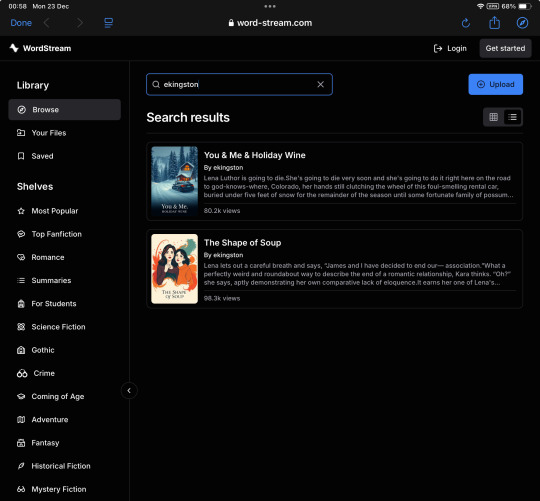
Because the tags on my fics (which included genres* and characters, but never the original IPs**) weren’t working, I put ‘Kara Danvers’ into the search bar and discovered that many more supercorp fics (Supergirl TV fandom, Kara Danvers/Lena Luthor pairing) were listed.
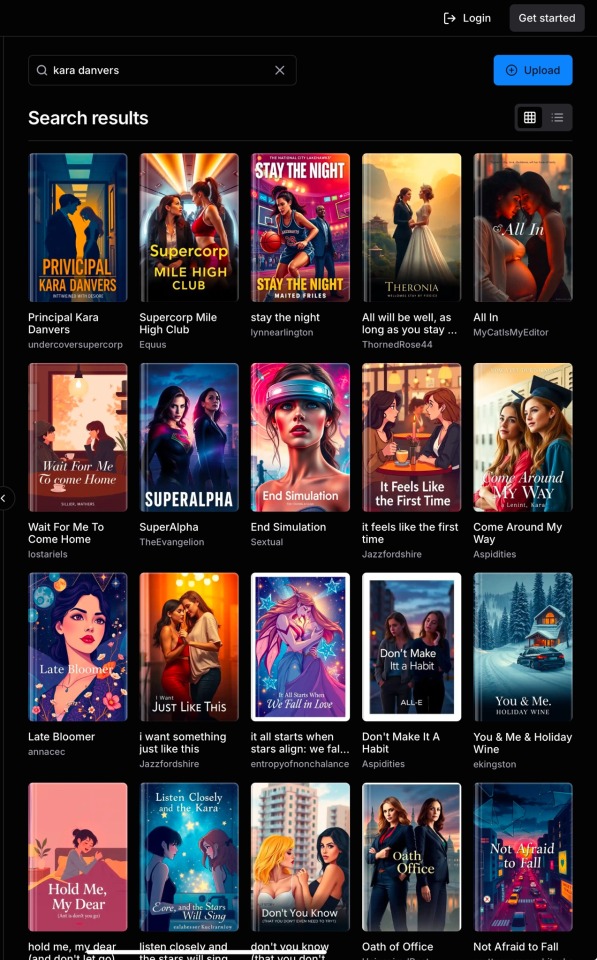
I went looking online for any mention of word-stream and AI plagiarism (the covers—as well as the ridiculously inflated number of reviews and ratings—made it immediately obvious that AI fuckery was involved), but found almost nothing: only one single Reddit post had been made, and it received (at that time) only a handful of upvotes and no advice.
I decided to make a tumblr post to bring the supercorp fandom up to speed about the theft. I draw as well as write for fandom and I’ve only ever had to deal with art theft—which has a clear set of steps to take depending on where said art was reposted—and I was at a loss regarding where to start in this situation.
After my post went up I remembered Project Copy Knight, which is worth commending for the work they’ve done to get fic stolen from AO3 taken down from monetized AI 'audiobook’ YouTube accounts. I reached out to @echoekhi, asking if they’d heard of this site and whether they could advise me on how to get our works taken down.

While waiting for a reply I looked into Copy Knight’s methods and decided to contact OTW’s legal department:
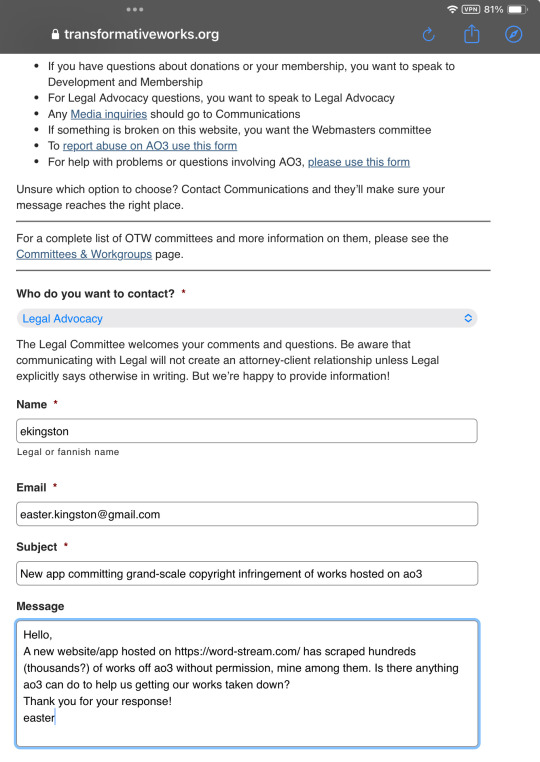
And then I went to bed.
By morning, tumblr friends @makicarn and @fazedlight as well as a very helpful tumblr anon had seen my post and done some very productive sleuthing:

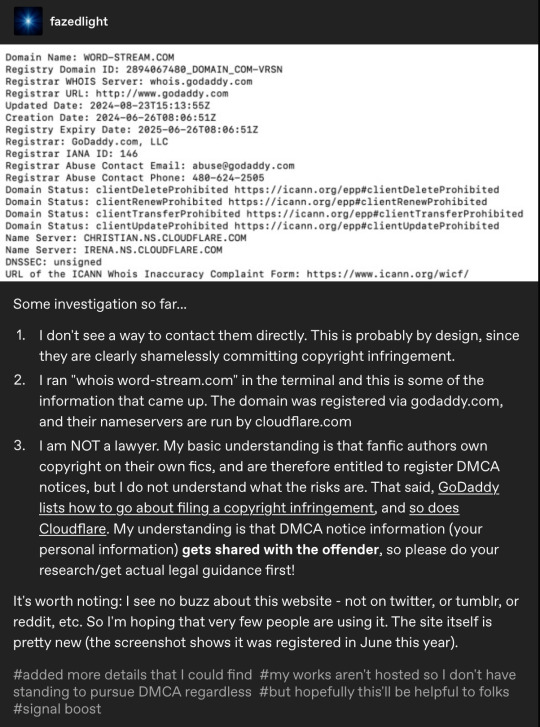
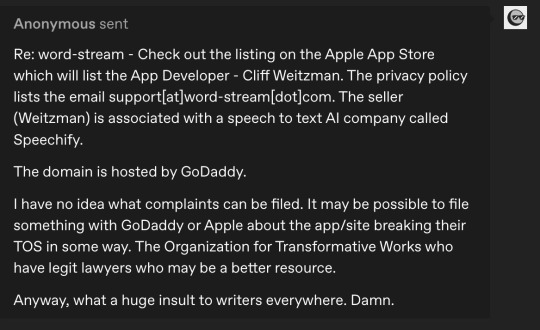
@echoekhi had also gotten back to me, advising me, as expected, to contact the OTW. So I decided to sit tight until I got a response from them.
That response came only an hour or so later:
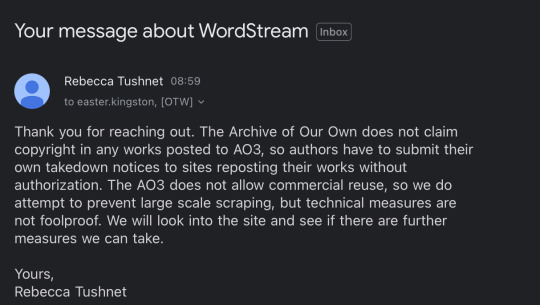
Which was 100% understandable, but still disappointing—I doubted a handful of individual takedown requests would accomplish much, and I wasn’t eager to share my given name and personal information with Cliff Weitzman himself, which is unavoidable if you want to file a DMCA.
I decided to take it to Reddit, hoping it would gain traction in the wider fanfic community, considering so many fandoms were affected. My Reddit posts (with the updates at the bottom as they were emerging) can be found here and here.
A helpful Reddit user posted a guide on how users could go about filing a DMCA against word-stream here (to wobbly-at-best results)
A different helpful Reddit user signed up to access insight into word-streams pricing. Comment is here.
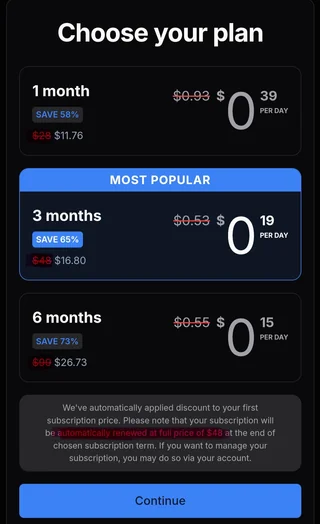
Smells unbelievably scammy, right? In addition to those audacious prices—though in all fairness any amount of money would be audacious considering every work listed is accessible elsewhere for free—my dyscalculia is screaming silently at the sight of that completely unnecessary amount of intentionally obscured numbers.
Speaking of which! As soon as the post on r/AO3—and, as a result, my original tumblr post—began taking off properly, sometime around 1 pm, jumpscare! A notification that a tumblr account named @cliffweitzman had commented on my post, and I got a bit mad about the gist of his message :

Fortunately he caught plenty of flack in the comments from other users (truly you should check out the comment section, it is extremely gratifying and people are making tremendously good points), in response to which, of course, he first tried to both reiterate and renegotiate his point in a second, longer comment (which I didn’t screenshot in time so I’m sorry for the crappy notification email formatting):
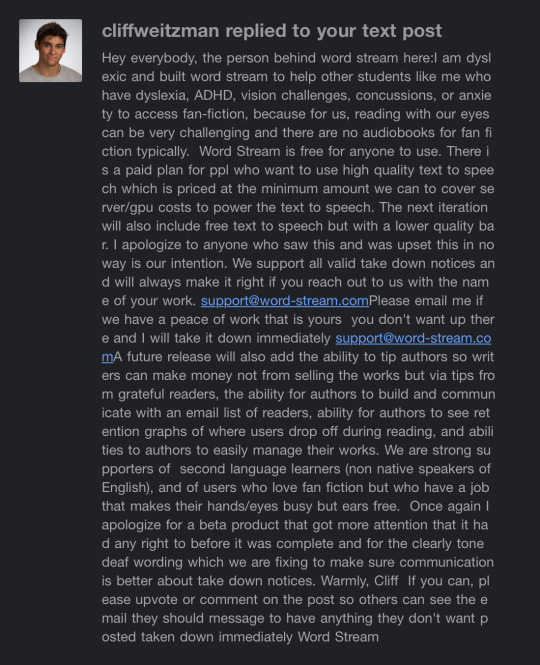
which he then proceeded to also post to Reddit (this is another Reddit user’s screenshot, I didn’t see it at all, the notifications were moving too fast for me to follow by then)
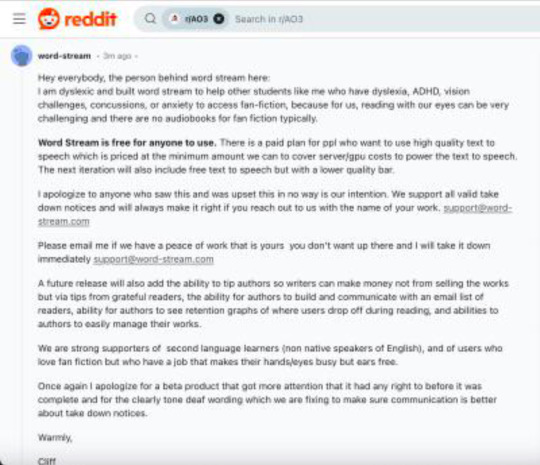
... where he got a roughly equal amount of righteously furious replies. (Check downthread, they're still there, all the way at the bottom.)
After which Cliff went ahead & deleted his messages altogether.
It’s not entirely clear whether his account was suspended by Reddit soon after or whether he deleted it himself, but considering his tumblr account is still intact, I assume it’s the former. He made a handful of sock puppet accounts to play around with for a while, both on Reddit and Tumblr, only one of which I have a screenshot of, but since they all say roughly the same thing, you’re not missing much:
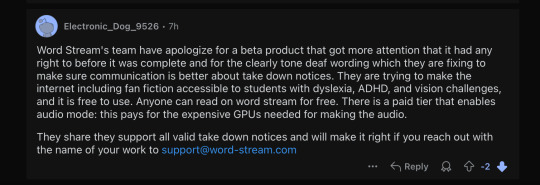
And then word-stream started throwing a DNS error.
That lasted for a good number of hours, which was unfortunately right around the time that a lot of authors first heard about the situation and started asking me individually how to find out whether their work was stolen too. I do not have that information and I am unclear on the perimeters Weitzman set for his AI scraper, so this is all conjecture: it LOOKS like the fics that were lifted had three things in common:
They were completed works;
They had over several thousand kudos on AO3; and
They were written by authors who had actively posted or updated work over the past year.
If anyone knows more about these perimeters or has info that counters my observation, please let me know!
I finally thought to check/alert evil Twitter during this time, and found out that the news was doing the rounds there already. I made a quick thread summarizing everything that had happened just in case. You can find it here.
I went to Bluesky too, where fandom was doing all the heavy lifting for me already, so I just reskeeted, as you do, and carried on.
Sometime in the very early evening, word-stream went back up—but the fan fiction category was nowhere to be seen. Tentative joy and celebration!***
That’s when several users—the ones who had signed up for accounts to gain intel and had accessed their own fics that way—reported that their work could still be accessed through their history. Relevant Reddit post here.
Sooo—
We’re obviously not done. The fanwork that was stolen by Weitzman may be inaccessible through his website right now, but they aren’t actually gone. And the fact that Weitzman wasn’t willing to get rid of them altogether means he still has plans for them.
This was my final edit on my Reddit post before turning off notifications, and it's pretty much where my head will be at for at least the foreseeable future:
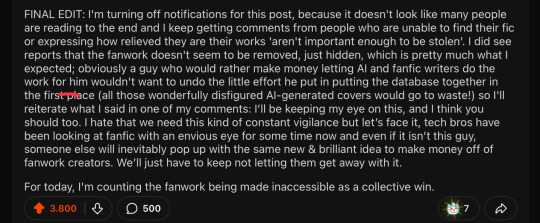
Please feel free to add info in the comments, make your own posts, take whatever action you want to take to protect your work. I only beg you—seriously, I’m on my knees here—to not give up like I saw a handful of people express the urge to do. Keep sharing your creative work and remain vigilant and stay active to make sure we can continue to do so freely. Visit your favorite fics, and the ones you’ve kept in your ‘marked for later’ lists but never made time to read, and leave kudos, leave comments, support your fandom creatives, celebrate podficcers and support AO3. We created this place and it’s our responsibility to keep it alive and thriving for as long as we possibly can.
Also FUCK generative AI. It has NO place in fandom spaces.
THE 'SMALL' PRINT (some of it in all caps):
*Weitzman knew what he was doing and can NOT claim ignorance. One, it’s pretty basic kindergarten stuff that you don’t steal some other kid’s art project and present it as your own only to act surprised when they protest and then tell the victim that they should have told you sooner that they didn’t want their project stolen. And two, he was very careful never to list the IPs these fanworks were based on, so it’s clear he was at least familiar enough with the legalities to not get himself in hot water with corporate lawyers. Fucking over fans, though, he figured he could get away with that.
**A note about the AI that Weitzman used to steal our work: it’s even greasier than it looks at first glance. It’s not just the method he used to lift works off AO3 and then regurgitate onto his own website and app. Looking beyond the untold horrors of his AI-generated cover ‘art’, in many cases these covers attempt to depict something from the fics in question that can’t be gleaned from their summaries alone. In addition, my fics (and I assume the others, as well) were listed with generated genres; tags that did not appear anywhere in or on my fic on AO3 and were sometimes scarily accurate and sometimes way off the mark. I remember You & Me & Holiday Wine had ‘found family’ (100% correct, but not tagged by me as such) and I believe The Shape of Soup was listed as, among others, ‘enemies to friends to lovers’ and ‘love triangle’ (both wildly inaccurate). Even worse, not all the fic listed (as authors on Reddit pointed out) came with their original summaries at all. Often the entire summary was AI-generated. All of these things make it very clear that it was an all-encompassing scrape—not only were our fics stolen, they were also fed word-for-word into the AI Weitzman used and then analyzed to suit Weitzman’s needs. This means our work was literally fed to this AI to basically do with whatever its other users want, including (one assumes) text generation.
***Fan fiction appears to have been made (largely) inaccessible on word-stream at this time, but I’m hearing from several authors that their original, independently published work, which is listed at places like Kindle Unlimited, DOES still appear in word-stream’s search engine. This obviously hurts writers, especially independent ones, who depend on these works for income and, as a rule, don’t have a huge budget or a legal team with oceans of time to fight these battles for them. If you consider yourself an author in the broader sense, beyond merely existing online as a fandom author, beyond concerns that your own work is immediately at risk, DO NOT STOP MAKING NOISE ABOUT THIS.
PLEASE check my later versions of this post via my main page to make sure you have the latest version of this post before you reblog. All the information I’ve been able to gather is in my reblogs below, and it's frustrating to see the old version getting passed around, sending people on wild goose chases.
Thank you all so much!
#fandom#plagiarism#AO3#speechify#word-stream#Cliff Weitzman#writers on tumblr#fan fic writing#AI plagiarism#independent authors#Ofek Weitzman#please share
47K notes
·
View notes
Text
Free Secure Web Hosting for Students or Individuals for Learning Purposes
दोस्त आज मैं आपको बहोत ही खास जानकारी देना चाहता हूँ जो शायद अभी तक आपको इसके बारे में पता नहीं होगा और इसीलिए आप इस आर्टिकल में आये है, अगर आपके पास होस्टिंग और डोमेन खरीदने के पैसे नहीं हैं, तो घबराने की जरूरत नहीं है। आज के इस आर्टिकल में मैं आपको बताऊंगा कि कैसे आप Free Resources का इस्तेमाल करके ब्लॉगिंग, वेबसाइट डिजाइनिंग, और वेब ड���वेलपमेंट जैसी Skills को बिना पैसे खर्च किए सीख सकते…
#best free hosting#best free hosting providers#blogging for beginners#blogging tips in Hindi#educational hosting#free domain#free domain for students#free hosting for students#free hosting resources#free web hosting#free web hosting and domain#free web hosting css#free web hosting for students#free web hosting html#free web hosting javascipt#free web hosting with cpanel#free website hosting for education#free wordpress hosting#google free website hosting#how to start blogging without money#learn web development#lifetime free web hosting#website designing free#wordpress free hosting
1 note
·
View note
Text
In the wake of the TikTok ban and revival as a mouthpiece for fascist propaganda, as well as the downfall of Twitter and Facebook/Facebook-owned platforms to the same evils, I think now is a better time than ever to say LEARN HTML!!! FREE YOURSELVES FROM THE SHACKLES OF MAJOR SOCIAL MEDIA PLATFORMS AND EMBRACE THE INDIE WEB!!!
You can host a website on Neocities for free as long as it's under 1GB (which is a LOT more than it sounds like let me tell you) but if that's not enough you can get 50GB of space (and a variety of other perks) for only $5 a month.
And if you can't/don't want to pay for the extra space, sites like File Garden and Catbox let you host files for free that you can easily link into NeoCities pages (I do this to host videos on mine!) (It also lets you share files NeoCities wouldn't let you upload for free anyways, this is how I upload the .zip files for my 3DS themes on my site.)
Don't know how to write HTML/CSS? No problem. W3schools is an invaluable resource with free lessons on HTML, CSS, JavaScript, PHP, and a whole slew of other programming languages, both for web development and otherwise.
Want a more traditional social media experience? SpaceHey is a platform that mimics the experience of 2000s MySpace
Struggling to find independent web pages that cater to your interests via major search engines? I've got you covered. Marginalia and Wiby are search engines that specifically prioritize non-commercial content. Marginalia also has filters that let you search for more specific categories of website, like wikis, blogs, academia, forums, and vintage sites.
Maybe you wanna log off the modern internet landscape altogether and step back into the pre-social media web altogether, well, Protoweb lets you do just that. It's a proxy service for older browsers (or really just any browser that supports HTTP, but that's mostly old browsers now anyways) that lets you visit restored snapshots of vintage websites.
Protoweb has a lot of Geocities content archived, but if you're interested in that you can find even more old Geocities sites over on the Geocities Gallery
And really this is just general tip-of-the-iceberg stuff. If you dig a little deeper you can find loads more interesting stuff out there. The internet doesn't have to be a miserable place full of nothing but doomposting and targeted ads. The first step to making it less miserable is for YOU, yes YOU, to quit spending all your time on it looking at the handful of miserable websites big tech wants you to spend all your time on.
#this is a side point so it's going here but I really think tech literacy should be a requirement in schools like math grammar history etc.#we live in a world so dominated by the stuff and yet a majority of the population does not understand it at even the most fundamental level#tiktok#tiktok ban#indie web#neocities#web development#current events#twitter#facebook#meta#amazon
7K notes
·
View notes
Text
How to Buy Website Hosting: A Step-by-Step Guide for Beginners
If you’re planning to launch a website, choosing the right web hosting is one of the first and most critical steps. The process can be daunting, especially if you're new to the tech world. But don’t worry! In this guide, I’ll walk you through how to buy website hosting, so you can make an informed decision and get your site live in no time.
What Is Website Hosting?
Before diving into the "how," let’s first address the "what." Website hosting is a service that allows your website to be accessible on the internet. It’s essentially the space where your website’s files, content, and data live. When someone visits your site, their browser communicates with the web host, which then delivers the files to their screen.
Different Types of Website Hosting
When you’re learning how to buy website hosting, it’s important to understand that there are several types of hosting available. Your choice will depend on the needs of your website.
Shared Hosting: This is the most common and budget-friendly option. Multiple websites share the same server, making it ideal for small businesses or blogs. However, it may have slower load times if the server gets too crowded.
VPS Hosting (Virtual Private Server): This type of hosting offers a more private server space, even though you’re still technically sharing the physical server. It’s a great middle ground between shared hosting and more expensive dedicated options.
Dedicated Hosting: If you have a large website with high traffic, dedicated hosting is your best bet. It’s pricier, but you get an entire server to yourself, giving you more control, speed, and security.
Cloud Hosting: This is a newer type of hosting where your website is hosted on a network of servers, ensuring that you’re not reliant on just one. It offers scalability, as you can easily add more resources as your site grows.
Key Factors to Consider When Buying Website Hosting
Now that you know the types of hosting, let’s move on to the factors you should consider when learning how to buy website hosting. Each of these aspects will play a role in determining whether a hosting plan is right for you.
Pricing: Hosting plans can range from a few dollars a month to hundreds. However, more expensive doesn’t always mean better. Make sure to choose a plan that fits your budget but still meets your site’s requirements. Always check for renewal rates, as they can sometimes be higher than the initial cost.
Bandwidth and Storage: These are key considerations. If your site is heavy on media or expects high traffic, you’ll need a plan with more bandwidth and storage. Many basic hosting plans offer unlimited bandwidth, but always read the fine print.
Uptime Guarantee: A host’s uptime guarantee ensures that your site remains live and accessible most of the time. Look for a host with at least a 99.9% uptime guarantee, as downtime can mean lost visitors and revenue.
Customer Support: Reliable customer support is essential, especially if you’re new to hosting. You’ll want 24/7 support, with options for live chat, email, or phone assistance. Some hosts even provide dedicated technical help.
Security Features: Your website’s security is paramount. When buying website hosting, make sure the provider offers robust security features such as SSL certificates, daily backups, and protection from malware and DDoS attacks.
Scalability: If you’re just starting, you might not need a lot of resources. But as your website grows, it’s important to choose a hosting provider that allows you to upgrade easily without much hassle.
Step-by-Step Guide on How to Buy Website Hosting
Now that we’ve covered the basics, let’s go through a step-by-step process of how to buy website hosting.
Identify Your Hosting Needs: Determine what type of website you’re building. Is it a simple blog, an e-commerce site, or a large corporate website? This will help you decide on the type of hosting you need.
Research Hosting Providers: Compare various hosting providers. Some popular options include Bluehost, HostGator, SiteGround, and GoDaddy. Look at their pricing, features, and customer reviews to get a feel for their reliability.
Choose a Plan: Once you’ve narrowed down your provider, select the plan that best suits your needs. Shared hosting is usually fine for small to medium-sized websites, while VPS or dedicated hosting may be needed for larger sites.
Register a Domain (If Needed): Many hosting companies offer a free domain registration for the first year. If you haven’t already purchased a domain, this can be a great way to save money.
Complete the Purchase: After selecting your plan and domain, proceed to checkout. Some hosting providers offer add-ons, like extra security or email services. Decide if you need these before finalizing your purchase.
Set Up Your Hosting: Once you’ve bought your hosting, you’ll receive an email with login details to your hosting dashboard. From here, you can install WordPress or other content management systems (CMS), upload files, and start building your site.
Launch Your Website: After setting everything up, all that’s left is to make your site live! Most hosting providers make this easy by offering one-click installs for WordPress and other popular platforms.
https://prinikacademy.com/how-to-buy-website-hosting/
#Website Hosting Tips#Hosting Setup Steps#Hosting vs Domain#Web Hosting Explained#Hosting for E-commerce
0 notes
Text
Best Blog Hosting

#best web hosting#best wordpress hosting#best hosting provider#best website hosting#cheap hosting#wordpress hosting#web hosting#hosting#web hosting services#blog tips
0 notes
Text

Transform your ideas into remarkable websites with the help of our cutting-edge tools from Techlogic Softwares. Design, develop, and shine in the digital realm! #techlogicsoftwares #webdevelopmentcompany
#webdevelopment#web hosting#website#web tools#webmarketing#social media marketing#digital marketing#marketing tips#online marketing#smm services#seo services#seo#webmaster#web maintenance services
0 notes
Text
Unleashing the Power of Free Web Hosting
Your Gateway to Online Presence In the ever-evolving landscape of the internet, establishing an online presence is crucial for individuals and businesses alike. Whether you’re a budding entrepreneur, a passionate blogger, or someone looking to showcase their portfolio, the first step is securing a reliable web hosting service. While many options exist, the allure of free web hosting is…

View On WordPress
#Budget-friendly sites#Digital presence#Free hosting benefits#Free web hosting#online presence#Web hosting options#Web hosting solutions#Website development#Website management#Website tips
0 notes
Text
youtube
Unlocking the Best Web Hosting: Live 30-Days Results Revealed
Now it's time to results of Top 10 Web Hosting Providers of 2023! Whether you're launching a new website, blog, or online business, choosing the right web hosting provider is crucial for success. In this video, we've researched and compiled a list of the top web hosting options to help you make an informed decision.
1 note
·
View note
Text
Thrive Architect Review: The Ultimate Website Builder | Bloggyideas
In this Thrive Architect review, we dive deep into its features, pros and cons, pricing, and more to help you decide if it's the right page builder for your website.
0 notes